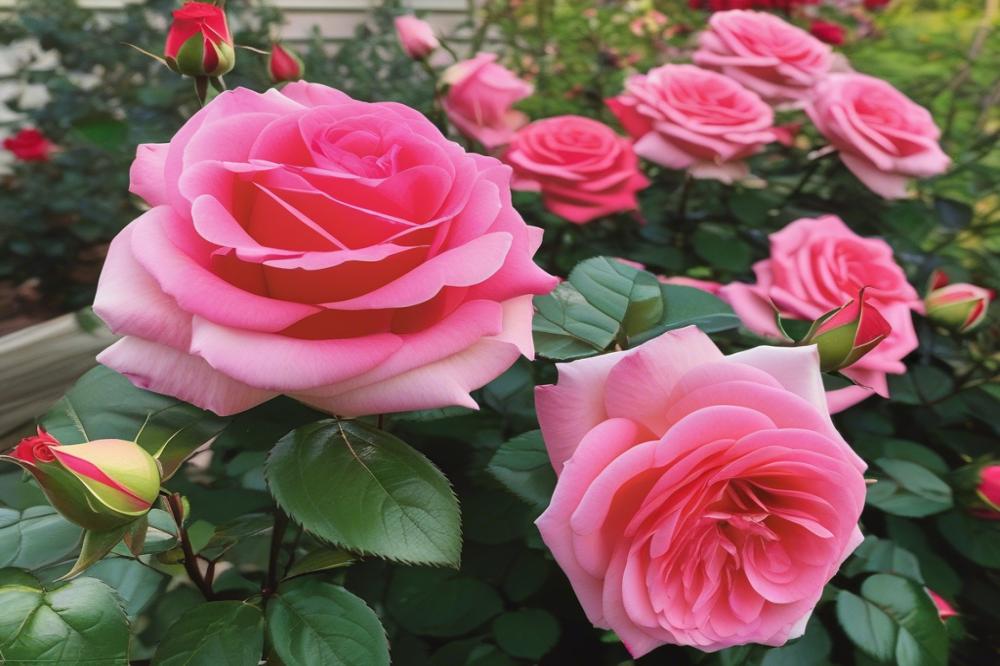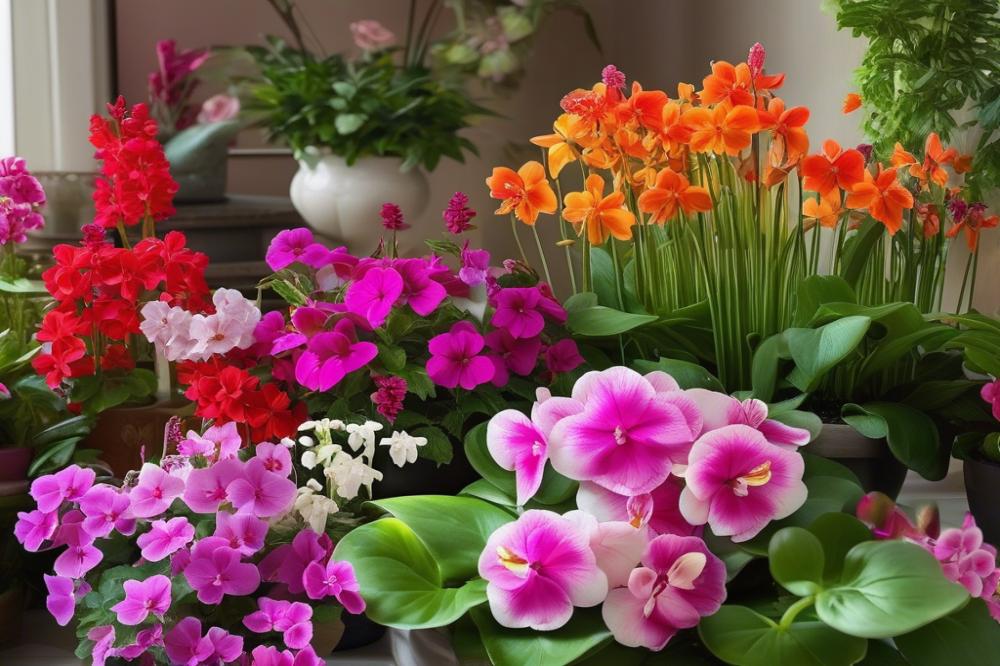How to Grow Beautiful Roses in Your Garden
Roses have fascinated people for centuries. Their vibrant colors and fragrant blooms bring joy and beauty to any garden. Whether it’s a single bloom or an entire bush, roses stand out as symbols of love and elegance. Many varieties exist, each offering something special. Some feature soft pastels while others boast bold, bright hues. In any garden, they are a sight to behold.
Understanding how to care for these remarkable flowers is essential. Proper attention to rose planting, along with thoughtful soil preparation, can greatly affect growth. Watering roses at the right intervals keeps them healthy. In addition, fertilizing roses with the proper nutrients strengthens their roots and supports beautiful blooms. This care lays the foundation for a thriving garden.
Beyond basic care, pruning roses helps shape the plants and removes dead wood. Regular maintenance also includes pest control, ensuring the plants remain vibrant and disease-free. Additionally, roses require adequate sunlight for optimal growth. Gardening tips abound when it comes to these flowers, yet knowing the essentials is key to success. With dedication and the right techniques, growing roses can be a rewarding hobby.
Embracing rose care means developing a relationship with these stunning plants. Understanding their needs will transform a basic garden into a floral paradise. Roses, with their unique charm, can easily become a gardener’s pride and joy. Start today, and soon enough, you might be the one sharing your blooming garden with friends and family.
growing roses

Creating a stunning rose garden can feel challenging, but with the right approach, it becomes an enjoyable endeavor. Begin by understanding the basics of rose planting. Healthy plants flourish in the right atmosphere, so getting the initial steps right is essential.
Key Considerations
Start with soil preparation. Roses thrive in well-drained, rich soils. Test your soil to check pH levels; aim for a slightly acidic range of 6.0 to 6.8. For a healthy growth environment, mix in organic compost or well-rotted manure to enrich the soil. This process not only helps with nutrient availability but also improves drainage.
Watering roses properly is crucial. These plants require consistent moisture, especially during dry spells. However, avoid creating soggy conditions which can lead to root rot. A deep watering session once a week is generally sufficient. Mulching around the base can help retain moisture and prevent weeds.
Rose Planting Techniques
When it comes to planting roses, timing is key. The best time for rose planting is during early spring, after the last frost. Choose a sunny location, as these flowers need at least six hours of direct sunlight daily. When planting, dig a hole that is about twice the size of the root ball. Place the rose bush in the center and fill the hole with soil.
Choosing the Right rose varieties
Many rose varieties offer unique colors and fragrances. Consider what fits best in your garden. Hybrid teas, floribundas, or climbing roses all have distinct characteristics. Choose types that suit your local climate and garden conditions. Hybrid tea roses are great for cut flowers, while floribundas provide a burst of color and fragrance throughout the season.
Fertilizing roses periodically helps them thrive. Use a balanced fertilizer during the growing season for the most effect. Follow the instructions carefully, as over-fertilizing can damage your plants. Additionally, keeping an eye on pest control is vital. Aphids and spider mites can ruin rose bushes quickly. Monitor your roses frequently; early detection leads to better outcomes.
Regular Maintenance
Pruning roses is another important care task. This encourages new growth and boosts flowering. Trim away dead or diseased stems before new buds start to form. Aim for pruning in late winter or early spring. Proper pruning techniques allow more sunlight and air to reach the inside of the bush.
To succeed with flower gardening, always stay educated. Read gardening tips, attend workshops, and connect with local gardening clubs. Don’t hesitate to ask for advice—many experienced gardeners are eager to share their knowledge. Creating the garden of your dreams just takes patience and persistence!
Soil Preparation

Importance of Soil Quality for Rose Health
Healthy roses start with quality soil. When you prepare your soil well, it supports the roots. Roots absorb nutrients and water, which are vital for growth. If the soil is poor, your rose plants won’t thrive. Scrawny plants and a lack of blooms result from weak soil conditions. Invest time in improving the soil before planting. This practice prevents future challenges.
Best Soil Types for Growing Roses
Roses prefer well-draining soil that is rich in organic matter. Loamy soil is the most suitable option. This mixture of clay, sand, and silt retains moisture but also allows excess water to flow away. A pH level between 6.0 and 6.8 is ideal for many rose varieties. Testing your soil can reveal important information about its composition. You might need to amend your soil to achieve the right conditions for these beautiful flowers.
Steps for Preparing Soil Before Planting
Begin the soil preparation process several weeks ahead of planting. First, clear the area of weeds and debris. A clean surface provides a strong start. Next, dig down about 12 inches to loosen the soil. This action helps improve drainage. After loosening, incorporate compost or well-rotted manure. These organic materials enrich the soil. Then, mix everything thoroughly.
Consider testing the soil pH now. Adjust it if necessary. Lime can raise pH, while sulfur can lower it. Water the prepared soil well afterward to settle it.
When your soil is ready, it will provide a strong foundation for watering roses and help them flourish. Follow these steps to enhance your flower gardening experience. Using this approach, you will likely see vibrant blooms, healthy foliage, and successful growth overall.
Watering Roses

Rose plants require careful attention when it comes to watering. It is essential to understand that different rose varieties may have unique needs. Some types thrive in drier conditions, while others prefer more moisture. Therefore, knowing your specific roses can make a significant difference in their health.
When planting roses, consider the soil preparation as it plays a vital role in moisture retention. Loamy soil mixtures with good drainage properties work best. These types of soil allow roots to absorb water without becoming waterlogged. If the soil is too compact, roots struggle, leading to poor growth. A balanced approach to soil preparation can significantly impact watering roses and overall health.
During the growing season, roses typically need about an inch of water per week. This amount may vary based on your local climate and rainfall. Water at the base of the plant instead of overhead. This practice minimizes the risk of disease by reducing humidity around the leaves. Furthermore, consistent moisture levels are crucial. Fluctuating conditions can stress the plant, making it vulnerable to pests and diseases.
Additionally, research shows that roses prefer deep watering rather than frequent shallow watering. This method encourages deeper root growth. Simply applying a light sprinkle each day can promote shallow roots. Aim to water early in the morning. This timing reduces evaporation rates and allows plants to absorb moisture before the heat of the day.
As seasons change, adjust your watering habits accordingly. Hotter months often require more frequent watering, while cooler months show reduced demands. Always observe your roses for signs of distress, such as wilting or yellowing leaves. These symptoms often indicate a need for different care.
Remember that mulching can be an incredibly beneficial practice. Adding a layer of mulch around the base can help maintain consistent moisture. It also suppresses weeds that compete for water. Using organic mulch is recommended, as it enriches the soil as it breaks down. Each layer of mulch can provide protection and retain moisture.
Lastly, don’t forget that factors like sunlight requirements can also affect watering needs. Roses exposed to full sun may dry out faster than those in partial shade. Additionally, considering other aspects like fertilizing roses can influence their water absorption. Healthy, vigorous plants may need different care compared to weaker ones. Adjusting these elements can help you nurture stunning blooms throughout the season.
Fertilizing Roses

Roses require specific nutrients to thrive. Nitrogen, phosphorus, and potassium are the key players when it comes to fertilizing these beautiful flowers. Nitrogen promotes healthy foliage growth, phosphorus supports strong root development, and potassium helps with flower formation. These elements work together to help your roses flourish.
Best Fertilizers for Roses
Choosing the right fertilizer can make a significant difference. A balanced fertilizer with equal parts nitrogen, phosphorus, and potassium is often ideal. Look for products labeled specifically for roses; they often contain additional micronutrients. Organic options, such as compost, can also enrich your soil. Consider utilizing rose-specific fertilizers available in liquid or granular forms. When applying, follow the manufacturer’s instructions closely. This practice will promote healthier growth.
Timing and Frequency of Fertilization
Plan to fertilize your roses during the growing season. Start in early spring when new growth emerges. Reapply every four to six weeks throughout the season. It’s essential to stop fertilizing in late summer. This timing helps prepare the plants for dormancy in winter. Ultimately, always monitor the condition of your roses. If the leaves are yellow or growth seems stunted, it may mean they need more nutrients. Keep an eye out for signs of deficiency, and adjust your fertilizing schedule accordingly.
Incorporate these fertilizing tips into your overall gardening tips. Healthy soil preparation will enhance the effects of fertilization. Don’t forget to combine regular watering roses with your fertilizing routine. Consistency yield results. Alongside fertilizing, pruning roses regularly will encourage new blooms. Observing sunlight requirements is critical, too. Beautiful roses emerge from an attentive garden that balances nutrients, water, and care.
Pruning Roses
Pruning is essential for the health and beauty of your rose plants. This practice removes dead or diseased wood and encourages new growth. Along with enhancing the plant’s shape, it helps improve airflow around the branches. Healthy roses are more vibrant and resilient against pests. If you want stunning blooms, pay attention to pruning.
Techniques for Effective Pruning
Begin by gathering the right tools. Sharp pruning shears and gloves are a must. Clean cuts minimize damage. Focus on removing any crossed branches, as they can rub against each other and create wounds. A good rule is to cut at a 45-degree angle to promote water runoff.
When you prune, think about the structure of the plant. Aim for an open center to allow sunlight to reach all parts. Cuts should be made just above a leaf node. This location encourages healthy new growth. Regularly checking and maintaining your roses will pay off immensely. Healthy plants produce more flowers.
When and How to Prune Different Rose Varieties
The timing of your pruning depends on the type of roses you have. For hybrid teas, prune in late winter or very early spring. However, bush roses thrive with a light pruning in fall. Floribundas can benefit from a good cut back in early spring before new growth starts.
When working with climbing roses, prune lightly. Focus on removing dead blooms and thin out excess growth. This keeps them manageable and promotes flowering. Always follow the specific needs of each rose variety. Soil preparation, watering roses, and fertilizing roses all play a role in their overall growth.
In summary, effective pruning requires knowledge of your rose varieties. Consider the right timing and techniques to keep your plants healthy. With the right care, you’ll enjoy the beauty of flourishing roses in your garden. Pest control also becomes easier when your plants have enough airflow. Pay heed to sunlight requirements as well. A well-pruned rose is a joy to behold.
Pest Control
Common pests that affect roses and their impact
Roses are susceptible to various pests. Aphids are tiny bugs that suck the sap from the plants. They can lead to stunted growth and yellowing leaves. Spider mites, on the other hand, create fine webs and can damage the foliage severely. Japanese beetles munch on the petals and can ruin your blooms. If left unchecked, these pests can threaten the health of your plants and, in some cases, even kill them.
Organic and chemical approaches to pest control
Using organic methods is a great choice for many gardeners. Insecticidal soap can effectively kill soft-bodied insects like aphids. Neem oil is another organic solution that disrupts the lifecycle of various pests. It is environmentally friendly and safe for beneficial insects. Chemical pesticides are also an option. While they can provide rapid results, they may harm helpful bugs and the environment if not used carefully. Reading labels and instructions closely is crucial when using these products.
Preventative measures to keep roses healthy
Healthy roses start with good practices. Regularly inspecting your plants helps catch problems early. Pruning roses not only improves airflow but also removes any diseased branches. Making sure they receive enough sunlight is vital too. Proper watering is essential; avoid watering the leaves to prevent mold growth. Fertilizing roses with the right nutrients supports robust growth. Implementing these gardening tips greatly reduces pest problems. After all, prevention is always better than a cure.
Sunlight Requirements
Understanding Sunlight Needs for Roses
Roses thrive best in full sunlight. They generally require at least six hours of direct sunlight each day. Insufficient light can lead to weak growth and fewer blooms. Take note that different rose varieties might have slightly different needs, but most will do well with ample sun.
Best Locations in the Garden to Plant Roses
Consider areas in your garden that receive adequate sunlight. The south or southwest side of your property is often ideal. Look for spots that are shielded from harsh winds but still bright. Avoid areas shaded by trees or tall structures. Not only will this promote healthy growth, but it can also enhance the beauty of your space.
How to Adjust for Varying Sunlight Conditions
If your garden has limited sunlight, choose roses that are sturdy in lower light conditions. Some varieties are more tolerant and can adapt. Pay attention to the shadows caused by buildings or trees, as they can change throughout the year. For areas with too much direct light, provide some afternoon shade. Using garden structures or tall plants as natural screens can help create a balance.
Additionally, soil preparation plays a key role. Good soil will help roses retain moisture while also promoting nutrient absorption. When watering roses, ensure that they receive enough but not too much. Monitor the moisture levels closely. Fertilizing roses properly will aid in growth and flowering. Pruning roses regularly will encourage healthy new growth and blooms. Don’t forget to be proactive with pest control to maintain the health of your plants.
Implement these gardening tips and watch your roses thrive. With the right approach to sunlight requirements, your flower gardening efforts will surely yield beautiful results.
Gardening Tips
General Tips for Successful Rose Cultivation
Planting roses requires careful consideration of the location. Choose a spot that enjoys plenty of sunlight each day. Most rose varieties thrive with at least six hours of direct sunlight. Prepare the soil well by mixing in compost or aged manure. This enriches the ground and helps your roses grow strong. When mulching, use organic materials to retain moisture and suppress weeds. Always keep the area around the base of the plant clear. Good air circulation is vital for healthy blooms.
Watering roses is crucial for their development. Water deeply but infrequently to encourage deeper root growth. If the leaves begin to wilt, that may be a sign of dehydration. Fertilizing roses can boost their growth. Use a balanced fertilizer during the growing season. Make sure to follow package instructions for the best results.
Common Mistakes to Avoid When Growing Roses
Many gardeners struggle with overwatering. This can lead to root rot and other issues. Ensure that you check the soil moisture before applying more water. Another common error involves neglecting pest control. Aphids and spider mites can ruin your plants. Regularly inspect your roses and treat any infestations swiftly.
Pruning roses is necessary for healthy growth. However, some people prune at the wrong times. The best periods are usually in late winter or early spring. Cut back any old or damaged wood to promote new growth. Avoid heavy pruning in the fall, as this can stress the plants before winter.
Additional Resources for Rose Gardening Enthusiasts
Numerous books and online resources offer guidance on rose planting. Visit your local library to explore available titles. Websites from reputable gardening organizations also provide valuable insights. Consider joining a rose society for community support and shared knowledge. Online forums allow you to connect with other flower gardening enthusiasts. Sharing tips and experiences can enhance your understanding of this beautiful craft. Document your growth journey and celebrate each bloom. Happy gardening!
Final Thoughts on Growing Beautiful Roses
Growing beautiful roses can be a rewarding experience. Remember, proper sunlight, well-drained soil, and regular watering form the foundation of any successful rose planting effort. Choosing the right rose varieties for your climate is essential. Different types have distinct needs, so select those that will thrive in your garden environment.
Also, don’t overlook the importance of regular pruning and pest management. These tasks might seem daunting at first, but they are crucial for maintaining healthy plants. With dedication, anyone can create a stunning display of vibrant blooms. The effort you put in will pay off as you watch your roses flourish.
Consider starting your journey in the world of rose cultivation today. Each blossom has a story, and they can brighten up any space. There is immense satisfaction in seeing your plants grow from humble seedlings to beautiful specimens. Gardening with roses not only enhances your landscape but can also bring a sense of peace and accomplishment.
As you immerse yourself in flower gardening, appreciate the small victories along the way. The joy of nurturing plants, the anticipation of blooms, and the eventual rewards can transform your outdoor space. Cultivating roses is about more than just gardening; it’s about connecting with nature and embracing creativity.
So, grab your tools, select your favorite varieties, and begin your rose adventure. Every gardener has a unique journey, and yours might just start with a single plant. Enjoy this beautiful process, and soon, you too will be surrounded by the lovely fragrance and colors of your own roses.



